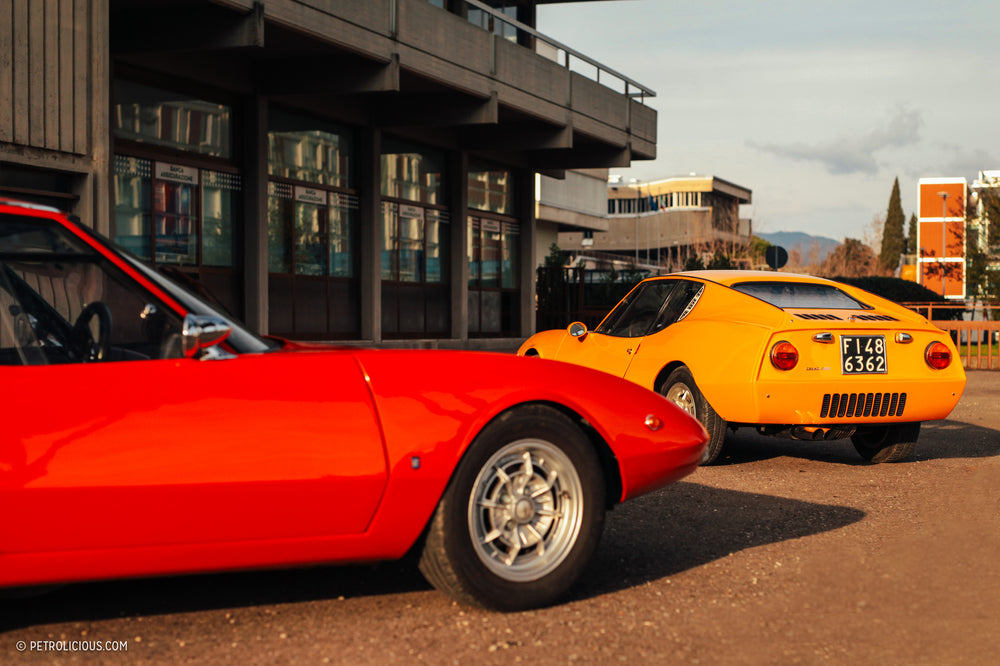Achieving a claimed 99mph from a diminutive 843cc, 43hp motor, the top speed statistic of the Lombardi Grand Prix clearly owed much to its aerodynamic shape. Which makes some sense, when you learn that Carrozzeria Francis Lombardi was founded by a World War One flying ace in 1947, who was originally building aircraft before the switch to a concentration on cars just three years later. The 1968 production release of the Grand Prix model was the coachbuilder's most well-known contribution to on-land motoring, though with production lasting just four years, only a small quantity of these unique machines were ever manufactured, making one, let alone two, a rare sight today.
Carlo “Francis” Lombardi had achieved eight kills in Italy’s struggle against the Austro-Hungarian Empire, including a reconnaissance flight some 100km deep into enemy territory. After the war’s culmination, Francis found he hadn’t tired of adventure and so undertook a series of long distance flights, including Vercelli (near Turin in northern Italy) to Tokyo, in an 85hp aircraft. Later setting up his own company in Vercelli, Carrozzeria Francis Lombardi based most of their designs on existing Fiat chassis, like this effort, the Grand Prix, built around a Fiat 850.




Utilizing the inline-four, rear-mounted engine—which had previously achieved a top output rating of 37hp—the Grand Prix retained the 850’s four-speed, rear-engine, rear-wheel drive configuration. The styling however, couldn’t have been more different. The in-house design was done by Giuseppe Rinaldi, featuring a steel unibody with a Kamm tail and a long, low bonnet that culminated in a sharp nose panel, with electrically powered retractable bucket headlights—“pop ups”—then a modern addition for the time and price tag of the car. These were constructed from fiberglass, as was the rear fascia and dash panel. Front suspension included traverse leaf springs below, with control arms above, and coil-sprung semi-trailing arms on the rear.



Further Grand Prix derivatives were built until production of the model ceased production in 1972. One such derivative was under the O.T.A.S. name, a collaboration between Lombardi and Giannini Automobili, utilizing the latter’s 982cc twin-came Tigre motor, while a downsized 817cc engine was installed for U.S. export in order to avoid emissions regulations. Abarth also created two versions: the first with a 903cc, 51hp engine; the latter, the Abarth 1300 Scorpione, featured a Fiat 124 engine bored out to 1280cc to produce 74hp.
Regarding the pair of cars in these photographs, both are official Lombardi Grand Prix 850s, and the red one was built in January 1968, making it one of the pre-series of 12 cars. It was found by the current owner in 1997, abandoned in a body shop in Florence, completely dismantled, rust-corroded, and with modified components. The extent of work required meant that the subsequent restoration took some five years to complete.






As a pre-series car, its specification deviates somewhat from the standard examples, seeing as it has an aluminum front hood and rear engine cover, and in total it clocks in some 100kg (~220lbs) lighter than a normal Grand Prix. It also features a racing style sliding side window.
The yellow example next to it is from July 1969. Acquired in 2016 from a body shop in Prato, Tuscany, fortunately it was found in good condition in regards to both the body and mechanics sheathed underneath, and the subsequent restoration only took a few months’ time.
Today the two cars boast all original parts except for the wheels, steering wheels, and exhausts, which are nonetheless from the era—period correct as they say, rather than retrofits.



“The pre-series was the most expensive to restore in terms of time and money,” says the owner of the two cars. “I completely restored the bodywork by hand, including the sheetmetal and accessories over the course of five years of labor. That may seem like a lot, but thanks to the fact that I was an auto body builder myself, in reality the cost for restoration was reduced considerably compared to what it would have amounted to if I’d brought it somewhere else.”
Restoration of the headlights also included a noteworthy process, he tells me. “I had to rebuild them from a healthy fiberglass basis, starting from the purchase of a chassis of another car. Then I had to make and shape the plaster moulds before finally building the fiberglass headlights with the casting process. These retractable headlights were pretty futuristic for their time, as very few cars were equipped with them in the late 1960s.”





What attracted our owner to the Grand Prix in the first place, I ask. “The passion for me happened immediately thanks to the design and its sporting lines. In fact, in 1970 when I first saw it I decided to buy it. It’s not only the external line, but the design which continue to the interior. The dashboard in a central position facing the driver has a which line that continues with the armrest and a single mould with the door.”
In the late 1960s, the Lombardi Grand Prix also represented a sports car which was a relatively achievable purchase, he explains. “The cost was accessible to many, and the simple Fiat mechanics made it practical to live with in terms of maintenance.”
And what is the car like to drive? “Even though there’s not a lot of power, it’s rear-engine, rear-wheel drive, and it’s nimble, so it makes great fun driving on a mixed route such as we find here around Florence and the hills of Chianti.”


The Grand Prix was never commercially viable for large scale production, neither having enough performance on the one hand, nor being quite cheap enough on the other. Fans of the mystique, exclusivity, and special design of the Lombardi Grand Prix can still expect to pay upwards of $40k for a nice example today.
The design is not the only attraction to these cars in the case of this owner though, who admits a sentimental reason for his passion for the Grand Prix; “It has an important emotional value to me, because inside this car I made my marriage proposal to my wife. We had our honeymoon in 1973 via Athens and Yugoslavia in the same car.”





















































